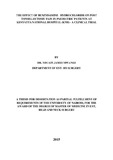| dc.contributor.author | Nduati, James M | |
| dc.date.accessioned | 2015-01-13T07:20:56Z | |
| dc.date.available | 2015-01-13T07:20:56Z | |
| dc.date.issued | 2014 | |
| dc.identifier.uri | http://hdl.handle.net/11295/79651 | |
| dc.description.abstract | Background: Tonsillectomy is one of the commonest operations in most ENT centers including Kenyatta National Hospital (KNH). It involves removal of palatine tonsils which can be achieved through several surgical techniques. In KNH blunt dissection method is used in all patients. This leaves a raw tonsillar bed which is a source of post-operative pain which most of the time may be dismissed as trivial although it causes dysphagia, otalgia and inability to speak properly.
Benzydamine Hydrochloride is a locally acting non-steroidal anti-inflammatory drug (NSAID) with local anaesthetic, and analgesic properties for pain relief. It is used for inflammatory conditions of the mouth and throat. Although it is sometimes used during the post-tonsillectomy period, its effectiveness had not been studied in our patient population.
Research question: How effective is Benzydamine hydrochloride in controlling Post tonsillectomy pain (PTP) in paediatric patients?
Objective:The study determined the effectiveness of Benzydamine hydrochloride oral pharyngeal gurgle in management of PTP in paediatric patients undergoing tonsillectomy at KNH.
Study methodology: The study was a randomised double blind clinical trialconducted in Kenyatta National Hospital (KNH)ENT-HN department, in Nairobi.106 patients aged between 4 and 12 yearswho were undergoing tonsillectomy for adeno-tonsillar hypertrophy or chronic recurrent tonsillitis were recruited via sequential random sampling and placed in any one of the two arms of the study. Informed consent was obtained from the parent/guardian.The perioperative profile forms were used to collect the patients’ details and characteristics. Information on pain control anddietaryoral intake was obtained for one week post-operatively and recorded in the visual Analogue Scale and dietary intake forms.
Analysis of Results: Statistical analysis was done using SPSS statistical package version 18 upon export of cleaned and entered data in excel data base. Descriptive analysis was done.The independent Student T test and Chi square test were used to compare data from the two groups for significant differences.
Results:Benzydamine hydrochloride oral pharyngeal gurgle was noted to have significant effect on reduction of PTP in all the days assessed. The greatest impact was on day 7 post operatively where 90.6% of patients in the test group had only mild pain compared to 49.1% of the control group ( p-Value <0.001) . This effect of pain control impacted on the oral intake significantly from day 4 post operatively where 42 of the test group patients were on soft diet while only 26 of the control group were on it(p-value 0.001).On day 7, 52 of the test patients were on either usual or soft diet while 43 of the control group were on soft diet.(p-value 0.01)
Conclusion:Benzydamine hydrochloride oral pharyngeal gurgle was found to be effective in management of PTP in paediatric patients four years and above. This effect on pain control was noted to be of beneficial effect on the patients in terms of early dietary oral intake | en_US |
| dc.language.iso | en | en_US |
| dc.publisher | University of Nairobi | en_US |
| dc.title | The effect of benzydamine hydrochloride on post tonsillectomy pain in paediatric patients at Kenyatta National Hospital (KNH). A clinical trial | en_US |
| dc.type | Thesis | en_US |
| dc.description.department | a
Department of Psychiatry, University of Nairobi, ; bDepartment of Mental Health, School of Medicine,
Moi University, Eldoret, Kenya | |
| dc.type.material | en_US | en_US |

